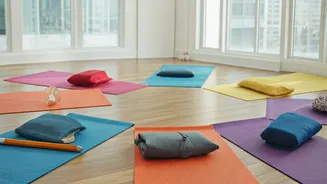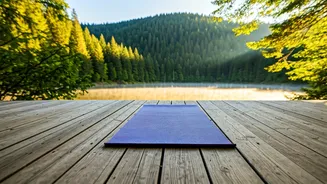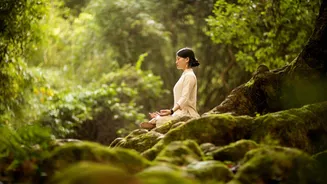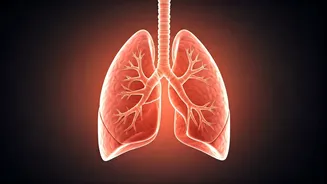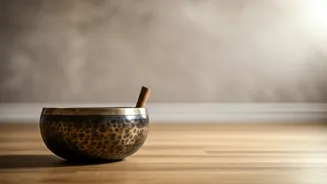Mountain Pose (Tadasana)
Tadasana, or Mountain Pose, forms the foundational element of many yoga sequences, teaching children the importance of grounding and stability. In this
pose, children are instructed to stand tall with their feet together, arms relaxed at their sides, and shoulders back. They are encouraged to lengthen their spine, as if a string is gently pulling them upwards, visualizing themselves as a strong, unwavering mountain. The pose promotes a sense of calm and body awareness, which aids in improving focus. By practicing Tadasana regularly, children can improve their posture, which subsequently enhances their ability to concentrate. This simple yet powerful pose, when integrated into a daily routine, helps children establish a mental and physical anchor, making them more resilient to distractions and improving overall cognitive function.
Tree Pose (Vrksasana)
Vrksasana, or Tree Pose, cultivates balance and concentration, encouraging children to focus on a single point to maintain stability. The child starts by standing in Tadasana, then shifts their weight to one foot, bringing the sole of the other foot to their inner thigh (above or below the knee, never on the knee). Arms are raised overhead, palms together or slightly apart, resembling the branches of a tree. The gaze is fixed on a still point in front of them, helping to maintain balance and focus. This pose not only improves balance but also strengthens leg muscles, enhancing coordination and body awareness. Regular practice helps children build mental resilience, fostering the ability to maintain concentration even amidst challenges. Tree Pose provides an opportunity for children to connect with their inner strength, enabling them to cultivate a sense of centeredness and improve their ability to manage stress.
Warrior II (Virabhadrasana II)
Virabhadrasana II, or Warrior II, builds strength, stamina, and focus, promoting a sense of empowerment in children. To perform this pose, children begin by standing with their feet wide apart, one foot turned out at a 90-degree angle, and the other slightly turned in. They bend their front knee over the ankle, ensuring the knee doesn’t extend past the toes. Arms are extended to the sides, parallel to the ground, with the gaze fixed over the front hand. This pose cultivates both physical and mental strength by demanding concentration on the alignment and the breath. It improves endurance, coordination, and body awareness, all essential elements for enhancing focus. Warrior II instills confidence and a sense of power, empowering children to tackle challenges with determination and poise. The steady gaze in the pose also helps to improve focus, helping children to maintain attention.
Downward Dog (Adho Mukha Svanasana)
Adho Mukha Svanasana, commonly known as Downward-Facing Dog, is an energizing pose that boosts circulation, stretches the body, and calms the mind, which is conducive to improved focus. Children start on their hands and knees, then lift their hips towards the ceiling, forming an inverted V-shape. They should keep their hands shoulder-width apart and their feet hip-width apart. This pose strengthens the whole body, especially the arms, legs, and core. Simultaneously, it stretches the hamstrings, shoulders, and spine. Downward-Facing Dog can help to reduce stress and fatigue, which in turn enhances concentration and memory. It also brings more blood flow to the brain, further improving cognitive function. By incorporating this pose into their routine, children experience a sense of revitalization and calmness, setting the stage for focused learning.
Child's Pose (Balasana)
Balasana, or Child's Pose, offers a moment of rest and rejuvenation, promoting relaxation and stress reduction, which is vital for improving focus and memory. Children begin by kneeling on the floor, bringing their big toes together and widening their knees. They then lower their torso onto their thighs, resting their forehead on the ground and extending their arms forward or placing them alongside their body. This gentle pose provides a deep sense of calm, allowing children to release tension and anxiety. It calms the brain and relieves fatigue, which enables them to focus better. Regular practice of Child's Pose provides a safe space for children to pause and center themselves, enhancing their ability to handle stress and improve their concentration levels. It creates a feeling of security and comfort, preparing them to learn and concentrate more effectively.
Cobra Pose (Bhujangasana)
Bhujangasana, or Cobra Pose, stretches the spine and stimulates the abdominal organs, promoting overall physical and mental well-being which supports improved cognitive function. Children lie on their stomachs, placing their hands under their shoulders. They then lift their chest off the ground, using their back muscles, while keeping their hips on the floor. This pose stretches the chest, abdomen, and spine, while strengthening the back muscles. Cobra Pose can help to alleviate fatigue and invigorate the mind, enhancing the capacity to concentrate. It also improves blood circulation, particularly in the brain, improving memory. When practiced consistently, this pose can help in increasing alertness and concentration. This pose is a good way to improve posture, boosting a child's confidence, which also indirectly helps with focus and attention span.
Boat Pose (Paripurna Navasana)
Paripurna Navasana, or Boat Pose, strengthens the core muscles and enhances balance, contributing to improved focus and coordination. The child sits with bent knees, feet lifted off the ground, balancing on the sitting bones. The torso leans back slightly, and arms can be extended forward, parallel to the floor. Boat Pose stimulates the abdominal organs and helps improve digestion, promoting a healthy body and mind. This pose demands core strength and balance, requiring focus and concentration. By practicing this pose regularly, children develop better body awareness and control, enhancing their ability to focus on tasks. The act of balancing also sharpens mental focus, making it a great exercise to boost concentration and memory retention. This pose is also a good way to build confidence and self-esteem as the child masters the pose.
Bridge Pose (Setu Bandhasana)
Setu Bandhasana, or Bridge Pose, stretches the chest, neck, and spine while calming the brain and reducing stress, which is important for enhancing cognitive function. The child lies on their back, bending their knees and placing their feet flat on the floor, hip-width apart. They then lift their hips off the ground, keeping their shoulders on the floor. Bridge Pose gently opens the chest and strengthens the back muscles, fostering better posture. It is a mood-boosting pose, helping to reduce anxiety and stress, hence promoting concentration and memory. This pose facilitates blood flow to the brain, which enhances cognitive functions. By practicing Bridge Pose regularly, children improve their spinal flexibility and strengthen their core, contributing to overall physical and mental well-being, which ultimately supports better focus.
Seated Forward Bend (Paschimottanasana)
Paschimottanasana, also known as the Seated Forward Bend, gently stretches the spine and calms the mind, helping children to feel centered and focused. The child sits with legs extended straight in front of them, then bends forward from the hips, reaching for their toes (or as far as they can comfortably reach). This pose stretches the hamstrings, spine, and shoulders. It is known to alleviate stress and reduce mild depression, which allows the child to concentrate better. The Seated Forward Bend promotes blood circulation to the brain, sharpening memory and enhancing overall cognitive function. It brings a sense of calm and clarity, providing an ideal environment for focused learning. Practicing this pose also improves flexibility and digestion, contributing to a balanced mind and body, which in turn enhances focus and memory.
Corpse Pose (Savasana)
Savasana, or Corpse Pose, the ultimate relaxation pose, allows children to integrate the benefits of their practice and promote deep relaxation, which is critical for consolidating memory. The child lies flat on their back, arms at their sides, palms facing up, and legs relaxed. They close their eyes and focus on their breath, allowing their body to relax completely. This pose provides a crucial opportunity for the body and mind to rest and rejuvenate. Savasana helps to reduce stress and anxiety, promoting a state of calm awareness. It also allows the body to restore energy, improving cognitive functions, including memory retention. By ending their practice with Savasana, children can experience the full benefits of their yoga session, feeling refreshed, focused, and ready to learn. Regular practice enhances overall well-being, paving the way for improved memory and concentration.
